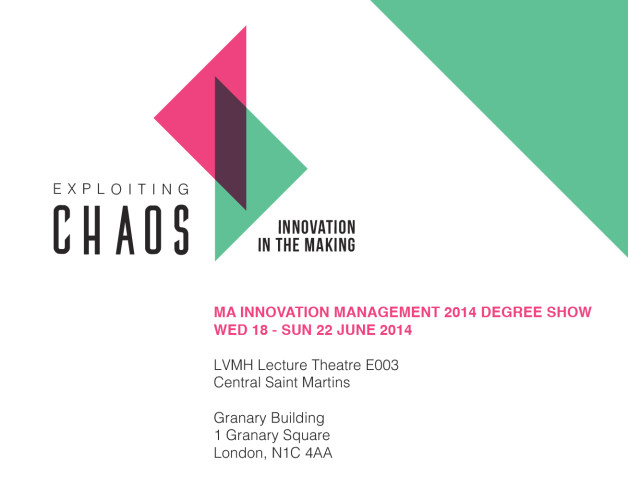2014年05月29日
【2014年6月18日から出展:UAL 卒展】玉田桃子さん MA Innovation Management@セントマーチンズ
9月から新学期が始まり、学年が終わる5月を過ぎるとロンドン芸術大学(UAL)はDegree Showと呼ばれる卒展シーズンに突入します。
そんな中、2012年9月にセントマーチンズのMA Innovation Management に入学した玉田桃子さんから久しぶりにお便りをいただきました。
 ご無沙汰しております。
ご無沙汰しております。
みなさまお元気でいらっしゃいますでしょうか?
2011年の秋頃から2012年の冬に掛けて、ショートコースの受講や当該コースへの出願の件でお世話になりました。2012年4月に無事にオファーを頂いた後、すっかりご無沙汰してしまい、恩知らず極まりなき自分を反省しています。
セントマのMA Innovation Managementに入学してからの日々は、まさにメンタル・ジェットコースター。ドロップアウトしてBAへ転部することなども考え、学校のメンタルサポートへも足を運び、、、といった感じでしたが、紆余曲折を経て、今夏の卒業が見えるところまでなんとか辿り着きました。
いろいろもがき、苦しみもしましたが、修士論文の中での一番の山場(10,000字のパート)も乗り越え、今は、かなりいい状態で最終の仕上げと卒展の準備に取り組んでいます。
本当にセントマのこのコースに入学して良かったと思っていますし、この2年間は、自分の人生において何物にも代え難い貴重な体験でした。(まだ、終わっていないけど、、、)ここで学んだことで、自分自身の秘めた特性や想いのようなモノに出会うこととなり、入学前には考えもしなかった道へと進んでいこうとしています。具体的には、まだ準備中というか、はっきりしないので、こういった言い方に留めますが、来るべきときが来たら報告させて頂きたく思います。
6月の卒展に向けて、私たちのコースでは、ウェブサイト上で全体的なコンセプトやカンファレンスの詳細、また個々の学生のファイナルプロジェクトを紹介することを始めました。
卒展情報のシェアも含めて、日本の人にももっともっと興味を持ってもらったり、知ってもらったりしたいなと思い、ユニコンさんに私が何か協力できることがあればと思っています。
私の在籍するコースは、セントマの中にあって、目に見える形で作品を生み出すのコースではない、というところに大きな特徴と、それゆえの理解されにくさがあるかと思います。
イノベーション・マネージメントというのは、科目の名前ではなく、イノベーションを探求していくプロセスそのものや、多様な人種的、職業的環境の中で、チームとして何かを生み出していくこと、表面的には見えにくい可能性を探ろうとしていくこと、その行為やマインドセットそのものをさしています。(と、私は理解しています。)
セントマでは、ほぼ唯一と言えるくらいアート&デザイン系のバックグラウンドがなくても、出願が可能な修士課程のコースで、物事を深く知っていこうという探究心&好奇心、やる気、負けん気で、なんとか乗り越えられます。(個人差はあるかと思いますが)
そういう意味では、もちろん、個々人の卒業後の展望や「何を学びたいか」によって、「有益か、否か」の判断が異なるというのは、ありますが、多くの人に門戸の開かれたコースではないかと思っています。
また、こちらで様々な日本人学生と話をしたり、間接的にでも見聞きする中で、あらゆる意味での「ミスマッチ」により、ネガティブな感情をコースや大学にもって、去っていく人も多いように感じてきました。その辺を埋める何かしらのお手伝いが私にできればいいなーと思います。
以上、長くなりましたが、よろしくお願いします。
MA Innovation Management
Degree Show(卒展)は6月18日(水)から22日(日)の間、セントマーチンズのキングスクロス校舎のLVMH Lecture Theatre E003で開催されます。
是非皆さん、足を運んでみてください!
http://mainnovationmanagement.co.uk/2014/03/26/from-chaos-to-innovation-our-maim-journey/

トップバッターは玉田さんの記事です。
A NEW VISTA FOR SERVICE DESIGN (サービス・デザイン:その新しい展望)
http://mainnovationmanagement.co.uk/2014/05/02/a-new-vista-for-service-design/

From personal experience in ‘pure service’ organisations I believe that the dynamism of frontline staff plays an important role in service innovation. In other words, the key differentiator in services is usually the person who delivers the service to the customer. This key factor however is often left undiscussed in service design innovation. Although much of the current innovation discussion focuses on ‘service’, most lean towards the technological developments that can enrich the customer or user experience. Feeling that the front-line staff element was missing, I sought to understand the reason for that gap in my research, while aiming to identify latent opportunities for innovation in service design.
When organizations give people a sense of meaning in their work, it’s not only good for employees, but it’s critical to build a healthy organization — one that is well-functioning and competitive. Keller and Price, 2011: Beyond Performance: How Great Organizations Build Ultimate Competitive Advantage
Conducting research into the world of services from an employee-centric perspective, I began by reviewing the current relevant literature. This exercise allowed me to understand how services have been perceived, researched and practiced in recent decades within the context of design, innovation and motivation, which helped illustrate the theoretical landscape around the issues. Apart from and in parallel to the literature, I collected and reviewed several Service Design Tools and attended the Service Design Network Conference to explore current practices among the community of service design practitioners. The current Service Design field is generally occupied by visually and digitally driven designers, although it is usually described as ‘cross-disciplinary’ or ’multi-disciplinary’. As they are not particularly close to face-to-face service delivery touch points, the emotional aspects of frontline staff might be missing from the Service Design landscape. Service Designers can diversify and extend their reach by incorporating psychological aspects such as ‘flow’ into their theory and practice. Frameworks such as the ‘Satisfaction Mirror’ support the theory that this additional element will aid in exploring human interaction in the service journey, from the employee or front-line staff’s perspective. Technological advancements will only increase, and continue to diversity the range of new services available. As these advancements continue, bringing with them not only opportunities but stark competition, it is important to remember that while technology is often easily replicable, an employee’s attitude towards their job is not as easy to imitate. To learn more about service design innovation, and Momoko’s research, please join us at the MA Innovation Management upcoming Degree Show, Exploiting Chaos: Innovation in the Making, from the 18-22 June.
Facebookページはこちら!
https://www.facebook.com/csmmaim?fref=nf
投稿者 unicon : 10:50